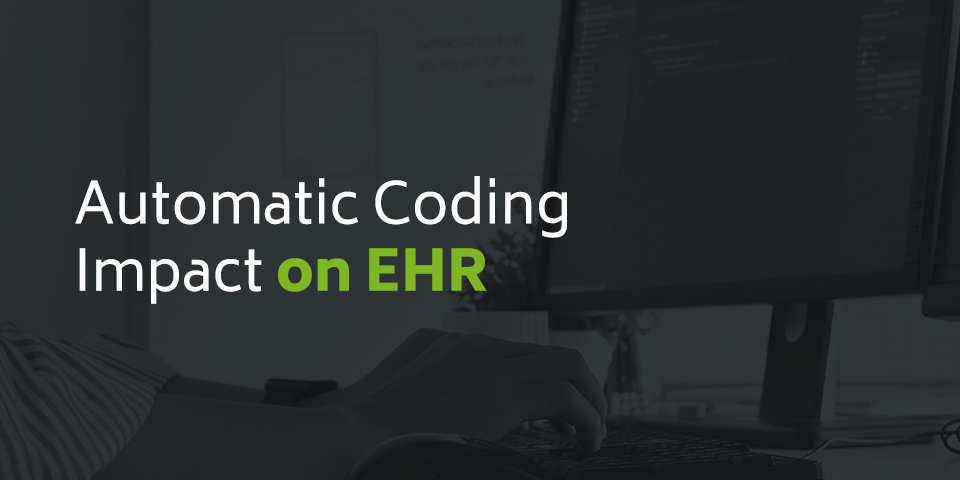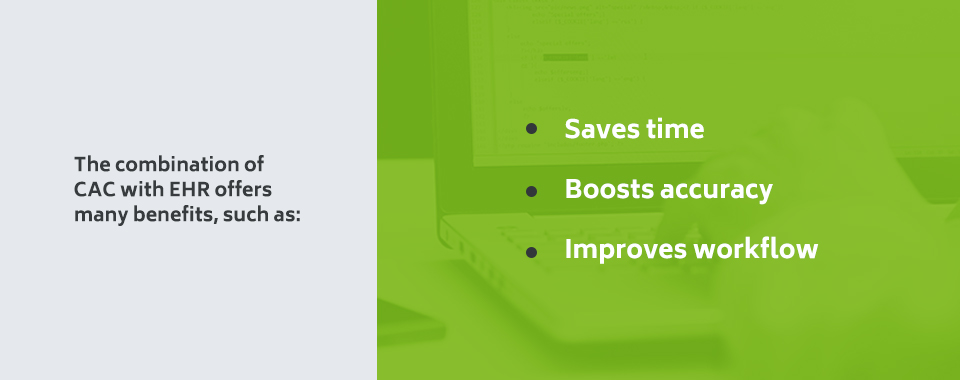Automatic Coding Impact on EHR
Computer-assisted coding (CAC) is a time-saving tool that accelerates the coding and billing process. CAC works by scanning and analyzing documents in an electronic health record (EHR), finding and highlighting key terminology and recommending appropriate codes for specific diagnoses and procedures. A human medical coder then reviews the results.
CAC is becoming increasingly relevant due to the implementation of the International Classification of Diseases-10th Revision-Clinical Modification (ICD-10-CM). According to the Centers for Disease Control and Prevention, the ICD-10-CM has almost five times as many codes as the previous version. Rather than try to learn thousands of new codes, health care staff can use CAC to quickly find the right codes and move onto the next task.
As with any new technology, some staff members may be hesitant to adopt CAC and feel concerned about its workflow. However, as many health care professionals say, CAC is worth learning and implementing due to its positive impact on productivity. This post will explore the benefits and challenges associated with CAC and how it enhances EHR.
Table of Contents
- How Computer-Assisted Coding Impacts EHR
- An Overview of the Current Coding Process in EHRs
- New Coding Opportunities and Challenges
- Try Automatic Coding With ICANotes
How Computer-Assisted Coding Impacts EHR
CAC makes it easier to submit accurate billing claims through an EHR system. With CAC, coders do not need to read through various documents searching for codes. Instead, they review the results provided by the CAC function in a user-friendly template.
EHR is a critical component in automatic coding because CAC can only scan electronic documents. With a higher number of health care practices switching from paper documentation to EHR, more coders can use CAC to their advantage. The combination of CAC with EHR offers many benefits, such as:
- Saves time: When the new ICD-10-CM was introduced, practitioners expected a drop in productivity as coders adjusted to the changes. One study found that the average coding time relating to the ICD-10-CM was nearly 70% longer than the coding time associated with the Ninth Revision. However, according to the American Health Information Management Association (AHIMA), CAC led to a 22% reduction in coding time per record. Automatic coding can help keep productivity levels high by decreasing the amount of time it takes to code.
- Boosts accuracy: Coders are under pressure to work as quickly as possible, potentially leading to errors. Learning new code sets can also increase the chance of making mistakes. When coders supplement their work with CAC, they can improve their speed without sacrificing accuracy.CAC improves accuracy through consistency and reducing the number of missed codes. This is a critical benefit of CAC because it helps providers avoid fraudulent claims as coding becomes more complicated.
- Improves workflow: When coders spend less time searching for codes or gathering paper documents, they can work more efficiently. This, in turn, helps billers submit insurance claims faster. Also, since CAC increases accuracy and helps ensure compliance with complex payer requirements, health care practices can expect fewer denied claims. As a result, staff members won't have to spend as much time correcting and resubmitting claims, and the workflow will improve overall.
For CAC to have the greatest impact, practices need to focus on increasing their use of EHR and reducing the number of paper documents they use.
An Overview of the Current Coding Process in EHRs
In general, coding involves converting text into codes. Without the use of CAC, coders manually review medical documents in the EHR. Coders may need to search for documents in various areas in the EHR. They need to know how to navigate the EHR efficiently to complete coding on time.
After coders locate the necessary documents, they assign and enter codes into the EHR. The codes must accurately represent a patient's diagnosis and treatment to get reimbursed and avoid claim issues. To find the correct codes, coders may refer to books or other reference sources.
When a health care practice integrates CAC with their EHR, coders spend more time in auditing roles. They review the codes provided by the CAC system and the matching documentation side-by-side. Their main job is to ensure the correct codes were chosen. They can then approve, change or reject the codes before they send the information to billing.
New Coding Opportunities and Challenges
Coders can be assured CAC will not replace them, and their expertise is still required for decision-making and coding accuracy. Coders are bound to appreciate CAC once they realize its impact on productivity and workflow. Combined with EHR, CAC offers the following opportunities:
- Builds computer skills: To be successful with CAC, coders need to learn how to navigate EHR systems. This may seem challenging at first, especially to coders who feel comfortable with paper documentation. However, CAC and EHR are easy to use once staff members become familiar with the technology. Coders need to build EHR and CAC skills to grow professionally, as both of these technologies are becoming more widespread.
- Enables remote work: EHR software allows easy and quick access to medical information from any location. Coders may be able to work remotely as long as the security requirements are met. This can lead to increased job satisfaction and a reduced turnover rate.
- Increases knowledge: CAC removes repetitive tasks from the daily routine and gives coders time to focus on more complex duties. Coders can use the extra time to build their knowledge of the ICD-10-CM and prepare professionally for future changes.
Despite the rewards, any new technology brings certain challenges. Coders will want to be aware of the following challenges associated with CAC:
- Requires accurate documentation: Since CAC reads text,it cannot work if it does not have detailed, accurate documentation to work with. Therefore, counselors, psychologists and other staff members still need to enter specific, well-written notes into the EHR. This will ensure they get the most accurate CAC response possible. An intuitive EHR system complements CAC and can help accelerate documentation.
- Calls for adequate training: Coders must be trained on how to use the EHR with CAC to make the most of these technologies. They must also be given enough time to learn how to create, find and read various notes.
- Is not a stand-alone solution: Even though CAC helps coders find the right codes, they still need to determine whether a CAC-chosen code fits a diagnosis or procedure correctly. Coders must realize that CAC is a tool to aid efficiency — not a replacement of their knowledge.
Try Automatic Coding With ICANotes
The future of automatic coding in healthcare is bright. As coding and billing tasks continue to become more involved, health care providers can turn to time-saving technology, such as EHR with CAC. These tools empower staff to code complex encounters with greater accuracy and less stress.
A well-structured, easy-to-access EHR system is critical for utilizing CAC. At ICANotes, we keep up with the latest EHR trends, including compliance requirements and efficiency-boosting tools like automatic coding, to help behavioral health professionals succeed. The ICANotes automatic coding feature calculates the Evaluation and Management codes with the highest reimbursement rates possible.
To learn more about ICANotes EHR and automatic coding, contact us today or request a free trial.
Related Posts
CPT Code Basics: What You Should Know
How to Prepare for an Insurance Treatment Review
Mental & Behavioral Healthcare Billing: How to Maximize Your Reimbursement Rate



